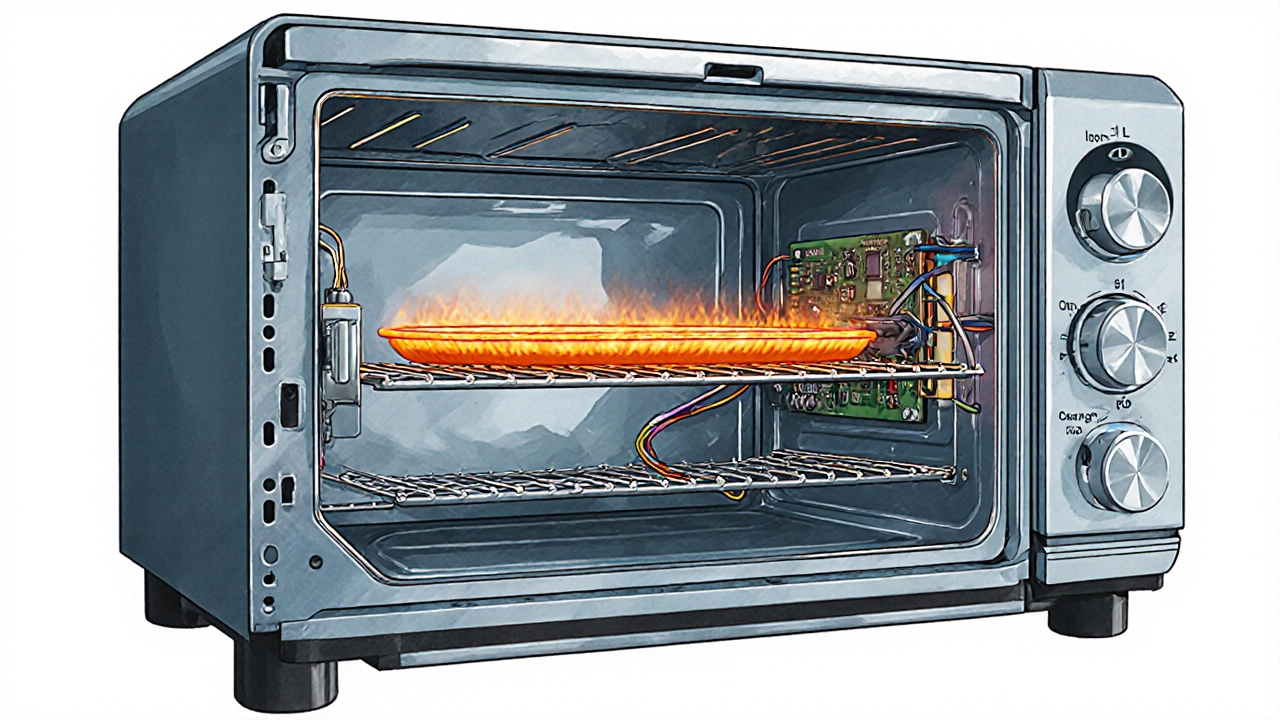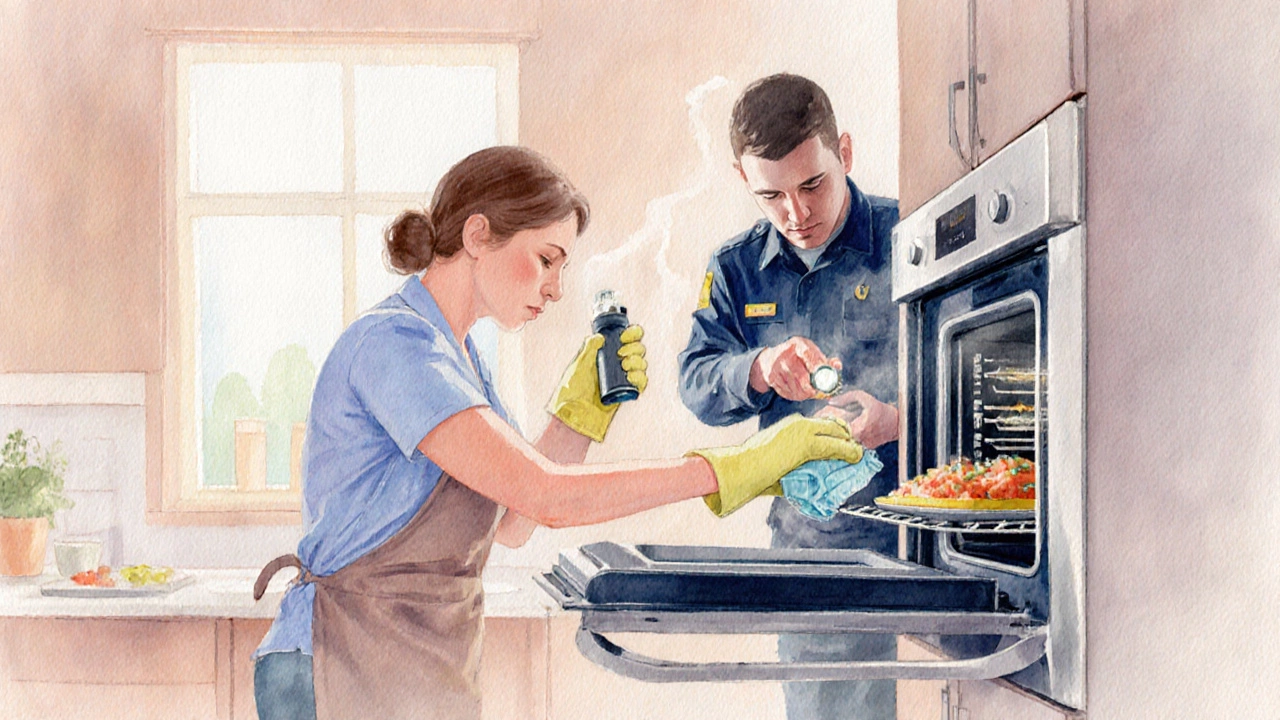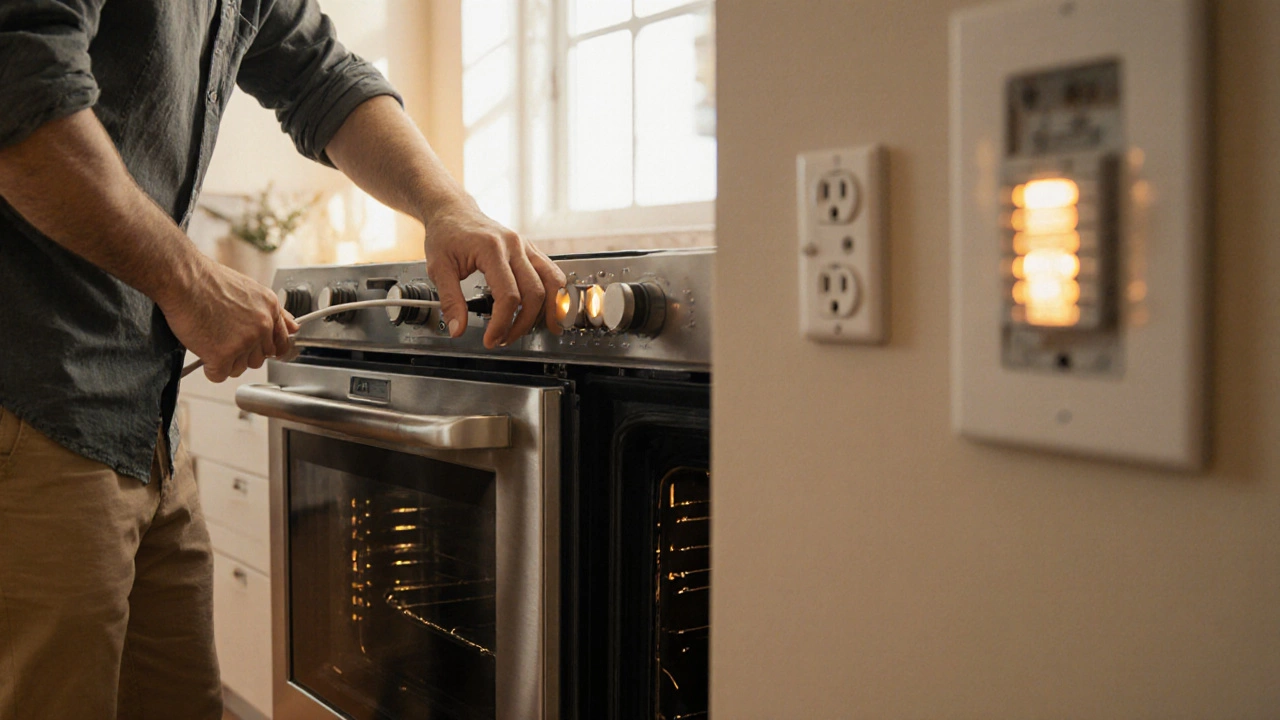Electric Oven Troubleshooting Guide
Problem Diagnosis
Select the symptoms you're experiencing with your electric oven to get targeted troubleshooting advice.
When your electric oven is a kitchen appliance that uses electric heating elements to bake, roast, and broil food suddenly refuses to heat, it can feel like the whole meal plan has collapsed. Before you call in a technician, a quick check‑list can save you time, money, and a lot of headache. Below you’ll find a step‑by‑step guide that walks you through the most common reasons an electric oven quits, how to test each component safely, and when it’s best to hand the job over to a professional.
Quick Diagnosis Checklist
- Is the oven plugged in and the outlet working?
- Has the circuit breaker tripped or a fuse blown?
- Do the oven’s lights or display work?
- Does the oven make any clicking or humming noises?
- Are any error codes flashing on the digital panel?
Answering these questions narrows the problem down to power supply, internal components, or control electronics.
1. Power Supply - The First Line of Defense
Even the most robust oven can’t work without a steady flow of electricity. Start by confirming the power source.
- Verify the plug is firmly seated in the wall outlet. A loose plug can cause intermittent power.
- Test the outlet with a multimeter or plug another device (like a lamp) into the same socket. If the secondary device doesn’t work, the outlet is likely dead.
- Locate your home’s breaker panel. Look for a breaker labeled "Kitchen" or "Oven." If it’s in the "off" position, flip it back on. If it trips again immediately, you have a short circuit somewhere in the oven.
- If your home uses fuses instead of breakers, inspect the relevant fuse for a broken filament or discoloration. Replace with the same amperage rating.
Once power is confirmed, move on to the oven’s internal safety devices.
2. The Power Cord and Plug Assembly
The power cord connects the oven to the household electrical supply and includes a built‑in fuse in many models can suffer from wear, cuts, or internal breaks.
- Unplug the oven and visually inspect the cord for cracks, fraying, or scorch marks.
- Using a continuity tester, check that the three wires (live, neutral, ground) each conduct from plug to the oven’s terminal block.
- If any wire shows no continuity, replace the cord - this is a relatively inexpensive part.

3. Internal Safety Switches
Modern ovens feature several safety mechanisms that shut off power when something isn’t right.
- Door switch prevents the oven from heating when the door is open: Open the oven door and listen for a faint click as the switch engages. Use a multimeter set to continuity; the circuit should close (show continuity) when the door is shut.
- Thermostat regulates temperature by turning the heating elements on and off: A faulty thermostat can think the oven is already at temperature, so it never powers the elements.
Replace a bad switch or thermostat with the exact part number listed in your oven’s manual.
4. Heating Elements - The Heart of the Oven
The heating element converts electrical energy into heat, typically a metal coil located at the top (broil) and bottom (bake) of the oven cavity is the most common culprit when an oven won’t heat.
- Turn the oven to a high temperature and let it run for a few minutes.
- Open the oven door (use heat‑resistant gloves) and look for a red or orange glow in the element. If it’s dark or has visible breaks, it’s likely dead.
- Turn off the oven, unplug it, and disconnect the element’s wires.
- Set your multimeter to ohms (Ω). A healthy element typically reads between 20‑50Ω.
- If the meter shows infinite resistance (open circuit) or a reading far outside the normal range, replace the element.
Most manufacturers sell separate bake and broil elements, and they’re often the cheapest parts you’ll replace.
5. Temperature Sensor (Thermistor)
The temperature sensor detects the oven’s internal temperature and sends data to the control board can drift over time, causing the oven to shut off prematurely.
- Locate the sensor (usually a thin metal rod on the back wall of the oven cavity).
- With the oven unplugged, disconnect the sensor connector.
- Measure resistance at room temperature; a typical sensor reads about 1kΩ at 70°F (21°C). Resistance should increase as temperature rises.
- If the reading is far off or the sensor is cracked, replace it.
6. Control Board and Clock/Timer Module
If power, switches, and elements all check out, the issue may lie in the control board the electronic brain that interprets button presses, runs cooking programs, and powers the heating elements. Signs of a failing board include:
- Blank or flickering display
- Error codes that don’t match the manual
- Randomly turning off during a cycle
Diagnosing a board often requires a service technician with a scope to check voltage outputs. If you’re comfortable with electronics, you can visually inspect for burnt components, bulging capacitors, or corroded contacts.

7. Common Failure Symptoms vs. Likely Causes
| Symptom | Most Likely Cause | Quick Test |
|---|---|---|
| Oven won’t heat at any temperature | Tripped circuit breaker or blown fuse | Check outlet, breaker, and fuse |
| Only the broil element works | Burnt bake element | Visually inspect and measure resistance |
| Temperature overshoots by 50°F+ | Faulty thermostat or temperature sensor | Measure sensor resistance, replace thermostat |
| Display is blank but oven still heats | Defective control board or power supply issue | Inspect board for burns, verify 120V at board input |
| Oven turns off mid‑cycle | Door switch intermittently opening or faulty board | Test door switch continuity with door closed |
8. Safety First - When to Stop and Call a Pro
Working with electricity is risky. If at any point you notice:
- Burning smells or smoke
- Repeated breaker trips despite a clean inspection
- Corroded wiring or water intrusion
- Uncertainty about reading multimeter values
Quit the DIY attempt and schedule a certified appliance repair technician. A professional can safely test high‑voltage components, replace control boards, and ensure the oven meets local electrical codes.
9. Preventive Maintenance Tips
- Clean the oven interior regularly to avoid grease buildup that can overheat elements.
- Check the door gasket for cracks; a poor seal forces the oven to work harder.
- Run a self‑diagnostic (if your model offers one) every six months.
- Inspect the power cord annually for signs of wear.
These habits can extend the life of your oven and reduce the likelihood of sudden failures.
electric oven not working can be frustrating, but most issues boil down to a handful of easy‑to‑test components. Armed with this guide, you can pinpoint the problem, decide whether a simple part swap will do the trick, or know exactly when it’s time to hand the job to a qualified repair service.
Frequently Asked Questions
Why does my oven heat on the broil setting but not on bake?
The broil and bake functions usually rely on separate heating elements. If the bake element is burnt out or its wiring is broken, only the broil element will work. Test the bake element’s resistance with a multimeter and replace it if you get an open‑circuit reading.
Can a tripped GFCI outlet affect my oven?
Yes. Some kitchens protect countertop outlets with GFCI devices. If the GFCI trips, the oven loses power. Reset the GFCI and check for any ground‑fault issues that might have caused the trip.
What does an error code "F1" mean on my electric oven?
Error codes vary by brand, but "F1" often points to a thermostat or temperature sensor fault. Refer to the oven’s user manual for the exact definition, then test the sensor’s resistance as described in the Temperature Sensor section.
Is it safe to replace the heating element myself?
Yes, if you follow safety steps: unplug the oven, verify the element is cool, disconnect the wiring, and use the correct replacement part. Many homeowners do it successfully, but always double‑check the resistance rating before installing.
Why does the oven door stay slightly ajar after I close it?
A misaligned door or a worn door hinge can prevent the latch from engaging fully, keeping the door switch open. Inspect the hinges, realign the door, and ensure the latch snaps into place. A properly closed door is essential for heating.
